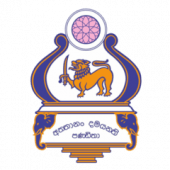
The College Crest is based on the ancient Buddhist symbol of “Triratna” (Three Jewels). The “Three Jewels” referred to here are the 3 pillars of Buddhism; Buddha, Dhamma, and Sangha. The version of the Triratna symbol used for the College Crest is one found at the Sanchi Stupa of India.
Mr. Justin Wijewardana, the creator of the College Crest, had said that he used the Triratna symbol as the basis of the College Crest because the College was founded for Buddhist students.
The flower-like structure at the top of the Triratna symbol and the two columns in the middle of it have been removed when it was used in the College Crest.
The Crest was first designed in 1941. Mr. Nandasiri Muthukumarana – a prestigious Old Rahulian, who was a student at that time – states that under the supervision of Mr. Justin Wijewardana, who designed the College Crest, Mr. W.A. Wikcramasinghe, who was an Old Rahulian himself, drew the first official College Crest on the stage of the then main hall for everyone to see.
In 1944, the College Crest was coloured for the first time. The colours Blue and Golden Yellow were used as the colours of the crest based on the Buddhist flag (Read more about College Colours.). The pink colour was used for the lotus symbol on the crest.
The College Motto is also used in the Crest. It was written using English alphabet. Long pronunciations were indicated by a bar above vowels. “Muurdhaja” letters were denoted by a dot under them.
In 1956, after Sinhala was recognized as the State Language of Sri Lanka, and after the school was acquired by the government according to government policies, then Teacher-in-Charge for Arts, Mr. Somapala Wijesundara changed the motto text in the Crest to Sinhala, under the direction of the then principal Mr. B.P. Ariyawansha.
The lion in the Crest symbolizes the prestige of the nation and advancing forward. Elephant heads symbolize the affiliation with the Matara region; the elephant was used in Matara region’s flags and symbols throughout history.
At the bottom of the Crest, the steps from the Triratna symbol have been depicted upside-down. It symbolizes the advancement of Rahulians to the top.
